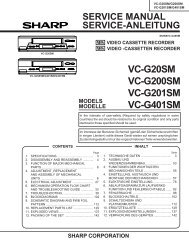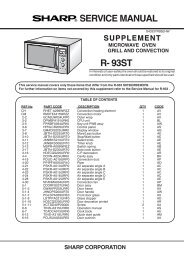You also want an ePaper? Increase the reach of your titles
YUMPU automatically turns print PDFs into web optimized ePapers that Google loves.
5-3-11 Video Sync Processing<br />
To extract the sync information from the video signal, a linear phase low-pass filter eliminates all noise and video<br />
contents above 1 MHz. The sync is separated by a slicer; the sync phase is measured. A variable window can be<br />
selected to improve the noise immunity of the slicer. The phase comparator measures the falling edge of sync, as well<br />
as the integrated sync pulse. The sync phase error is filtered by a phase-locked loop that is computed by the Fast<br />
Processor. All timing in the front-end is derived from a counter that is part of this PLL, and it thus counts synchronously<br />
to the video signal. A separate hardware block measures the signal back porch and also allows gathering the<br />
maximum/minimum of the video signal. This information is processed by the FP and used for gain control and<br />
clamping. For vertical sync separation, the sliced video signal is integrated. The FP uses the integrator value to derive<br />
vertical sync and field information. The information extracted by the video sync processing is multiplexed onto the<br />
hardware front sync signal (FSY) and is distributed to the rest of the video processing system.<br />
The data for the vertical deflection, the sawtooth, and the East-West correction signal is calculated by the VCT 38xxA.<br />
5-3-12 Display Processing<br />
In the display processing the conversion from digital YC r C b to analogue RGB is carried out.<br />
In the luminance processing path, contrast and brightness adjustments and a variety of features, such as black-level<br />
expansion, dynamic peaking and soft limiting, are provided. In the chrominance path, the C r C b signals are converted<br />
to 4:4:4 format and filtered by a colour transient improvement circuit. The YC r C b signals are converted by a programmable<br />
matrix to RGB colour space. The digital OSD insertion circuit allows the insertion of a 5-bit OSD signal.<br />
The OSD signals and the display clock are synchronised to the horizontal flyback.<br />
5-3-13 Chroma Transient Improvement<br />
The intention of this block is to enhance the chroma resolution. A correction signal is calculated by differentiation of<br />
the colour difference signals. The differentiation can be selected according to the signal bandwidth, e.g. for PAL/NTSC/<br />
SECAM or digital component signals, respectively. The amplitude of the correction signal is adjustable. Small noise<br />
amplitudes in the correction signal are suppressed by an adjustable coring circuit. To eliminate ‘wrong colours’, which<br />
are caused by over and undershoots at the chroma transition, the sharpened chroma signals are limited to a proper value<br />
automatically.<br />
5-3-14 Video Back-end<br />
The digital RGB signals are converted to analogue RGBs using three video digital-to-analogue converters (DAC) with<br />
10-bit resolution. An analogue brightness value is provided by three additional DACs. The adjustment range is 40 % of<br />
the full RGB range. Controlling the white-drive/analogue brightness and also the external contrast and brightness<br />
adjustments is done via the Fast Processor, located in the front-end. Control of the cutoff DACs is done via I 2 C bus<br />
registers. Finally cutoff and blanking values are added to the RGB signals. Cutoff (dark current) is provided by three 9bit<br />
DACs. The adjustment range is 60 % of full scale RGB range. The analogue RGB-outputs are current outputs with<br />
current-sink characteristics. The maximum current drawn by the output stage is obtained with peak white RGB. An<br />
external half contrast signal can be used to reduce the output current of the RGB outputs to 50% . Cutoff and whitedrive<br />
current measurement are carried out during the vertical blanking interval. They always use the small bandwidth<br />
setting.<br />
- 45 -







